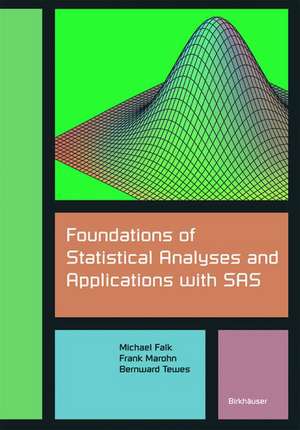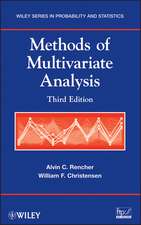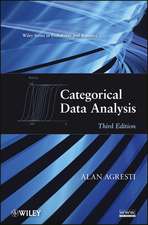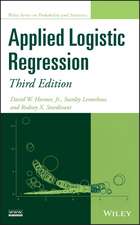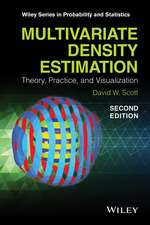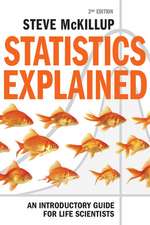Foundations of Statistical Analyses and Applications with SAS
Autor Michael Falk, Frank Marohn, Bernward Tewesen Limba Engleză Paperback – iun 2002
There exists, consequently, a bit of a dichotomy between theoretical and applied statistics, and this book tries to straddle that gap. It links up the theory of a selection of statistical procedures used in general practice with their application to real world data sets using the statistical software package SAS (Statistical Analysis System). These applications are intended to illustrate the theory and to provide, simultaneously, the ability to use the knowledge effectively and readily in execution.
Preț: 398.35 lei
Nou
Puncte Express: 598
Preț estimativ în valută:
76.23€ • 81.51$ • 63.55£
76.23€ • 81.51$ • 63.55£
Carte tipărită la comandă
Livrare economică 17 aprilie-01 mai
Preluare comenzi: 021 569.72.76
Specificații
ISBN-13: 9783764368937
ISBN-10: 3764368934
Pagini: 412
Ilustrații: X, 402 p. 146 illus.
Dimensiuni: 170 x 244 x 22 mm
Greutate: 0.66 kg
Ediția:2002
Editura: Birkhäuser Basel
Colecția Birkhäuser
Locul publicării:Basel, Switzerland
ISBN-10: 3764368934
Pagini: 412
Ilustrații: X, 402 p. 146 illus.
Dimensiuni: 170 x 244 x 22 mm
Greutate: 0.66 kg
Ediția:2002
Editura: Birkhäuser Basel
Colecția Birkhäuser
Locul publicării:Basel, Switzerland
Public țintă
Professional/practitionerCuprins
1. Elements of Exploratory Data Analysis.- 2. Some Mathematical Statistics for the Normal Distribution.- 3. Regression Analysis.- 4. Categorical Data Analysis.- 5. Analysis of Variance.- 6. Discriminant Analysis.- 7. Cluster Analysis.- 8. Principal Components.- Appendix: A Brief Introduction to SAS.- A.1 Preface.- A.1.1 SAS—Modules.- A.1.2 Different Modes with SAS.- A.2 Fundamentals of SAS Programming.- A.2.1 The Display Manager System.- A.2.2 DATA and PROC Steps.- A.2.3 Some Basic SAS Statements.- A.2.4 Programming in a DATA Step.- A.3 Some SAS Procedures.- A.3.1 PROC MEANS.- A.3.2 PROC GPLOT.- A.3.3 PROC IML.- Data Index.
Textul de pe ultima copertă
The analysis of real data by means of statistical methods with the aid of a software package common in industry and administration will certainly be part of a future professional work of many students in mathematics or mathematical statistics.
Commonly there is no natural place in a traditional curriculum for mathematics or statistics, where a bridge between theory and practice fits into. On the other hand, the demand for an education designed to supplement theoretical training by practial experience has been rapidly increasing.
There exists, consequently, a bit of a dichotomy between theoretical and applied statistics, and this book tries to straddle that gap. It links up the theory of a selection of statistical procedures used in general practice with their application to real world data sets using the statistical software package SAS (Statistical Analysis System). These applications are intended to illustrate the theory and to provide, simultaneously, the ability to use the knowledge effectively and readily in execution.
An introduction to SAS is given in an appendix of the book. Eight chapters present theory, sample data and SAS realization to topics such as regression analysis, categorial data analysis, analysis of variance, discriminant analysis, cluster analysis and principal components.
This book addresses the students of statistics and mathematics in the first place. Students of other branches such as economics or biostatistics, where statistics has a strong impact, and related lectures belong to the academic training, should benefit from it as well. It is also intended for the practitioner, who, beyond the use of statistical tools, is interested in their mathematical background.
Commonly there is no natural place in a traditional curriculum for mathematics or statistics, where a bridge between theory and practice fits into. On the other hand, the demand for an education designed to supplement theoretical training by practial experience has been rapidly increasing.
There exists, consequently, a bit of a dichotomy between theoretical and applied statistics, and this book tries to straddle that gap. It links up the theory of a selection of statistical procedures used in general practice with their application to real world data sets using the statistical software package SAS (Statistical Analysis System). These applications are intended to illustrate the theory and to provide, simultaneously, the ability to use the knowledge effectively and readily in execution.
An introduction to SAS is given in an appendix of the book. Eight chapters present theory, sample data and SAS realization to topics such as regression analysis, categorial data analysis, analysis of variance, discriminant analysis, cluster analysis and principal components.
This book addresses the students of statistics and mathematics in the first place. Students of other branches such as economics or biostatistics, where statistics has a strong impact, and related lectures belong to the academic training, should benefit from it as well. It is also intended for the practitioner, who, beyond the use of statistical tools, is interested in their mathematical background.
